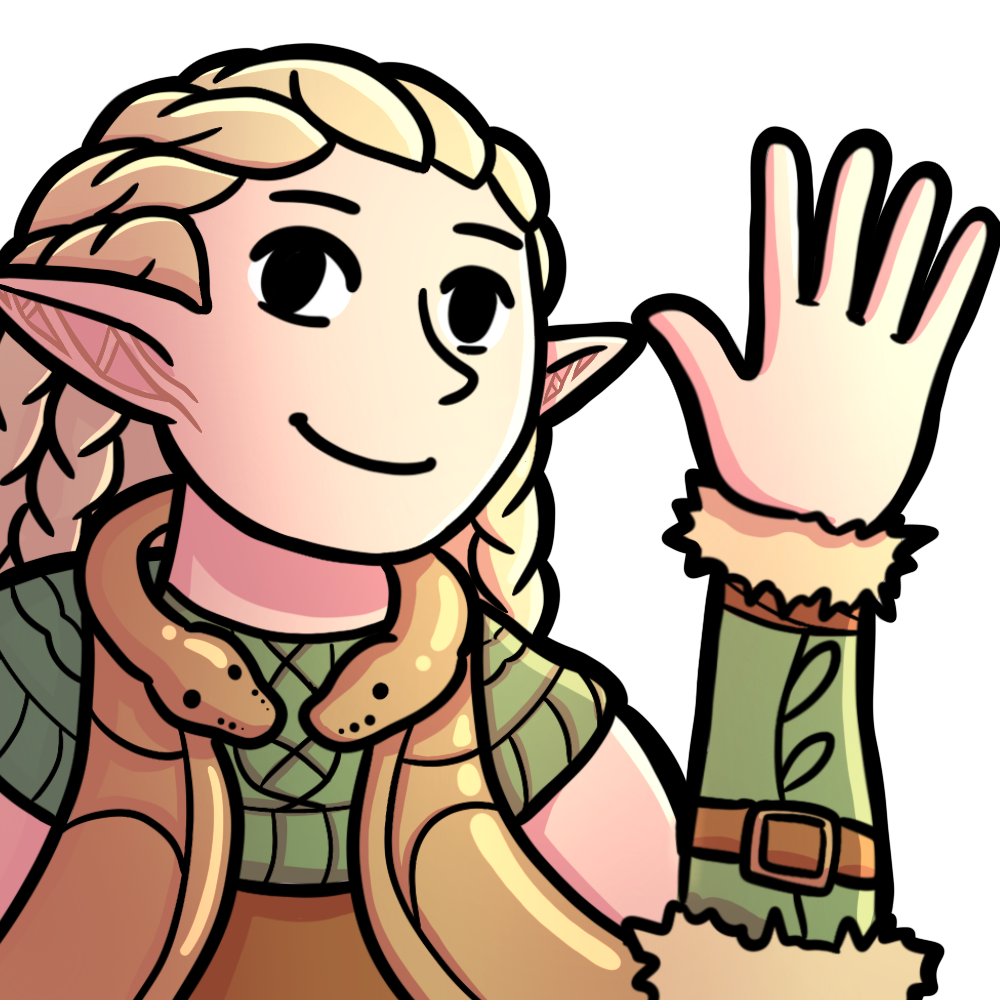Slogurk Midrange/Prison in Standard
11/10/2023
The current Standard format is quite underexplored, in my opinion.
Part of the reason is that there's very little reason to explore it - after Worlds 2023 in September, there haven't really been anything in terms of big Standard tournaments. The upcoming RCs are all Pioneer, and PT Chicago is as well. WotC has said they plan to revitalize Standard, but we haven't yet seen that happen much.
Worlds and WOE certainly brought a bunch of innovation - the domain ramp decks got better, midrange lists shifted from UB to Esper and Golgari, and Soldiers was somewhat revitalized. But even still, I think there's a lot more depth.
Plumbing those depths might not be immediately useful right now, with nothing major coming up. But with Standard expanded to 3 years, these cards will still be legal for quite some time, and possibly still quite relevant then. And besides, it's fun!
So, let me introduce you to
Slogurk.Part 1: A Bit of History
The first time I heard of Slogurk doing anything in Standard was back in March 2023, as I was preparing for RC San Diego with the Sanctum for All testing team. This was all the way back before Team Handshake took down PT MOM with Rakdos, when the deck to beat was still Grixis Midrange, with
Bloodtithe Harvester, Corpse Appraiser, Fable and Invoke Despair.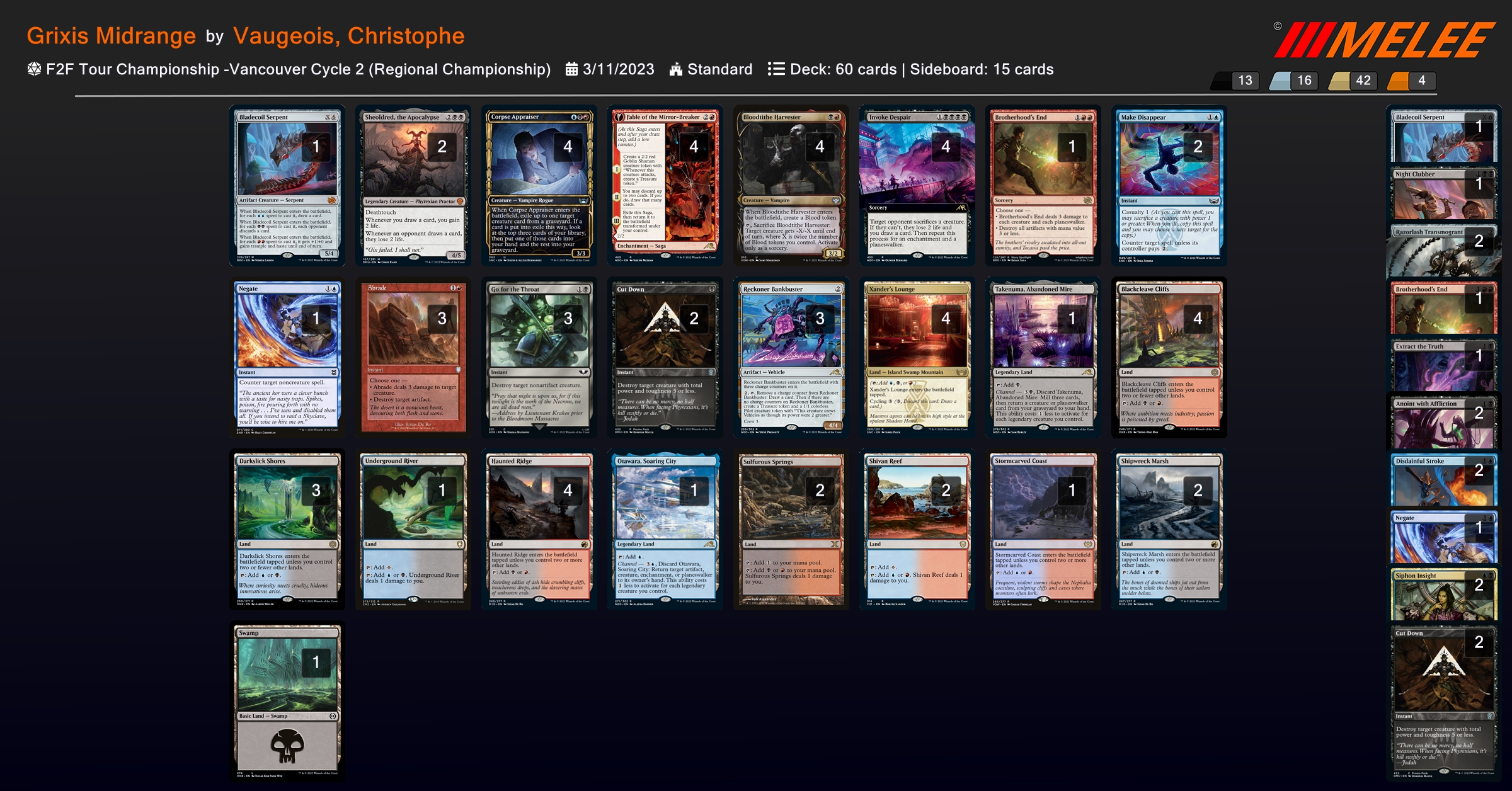
the meta deck at the time
At the time there was also an aggressive Esper Legends deck. And at some point, a version of it that added a fourth color for Slogurk placed second in a Canadian RC!
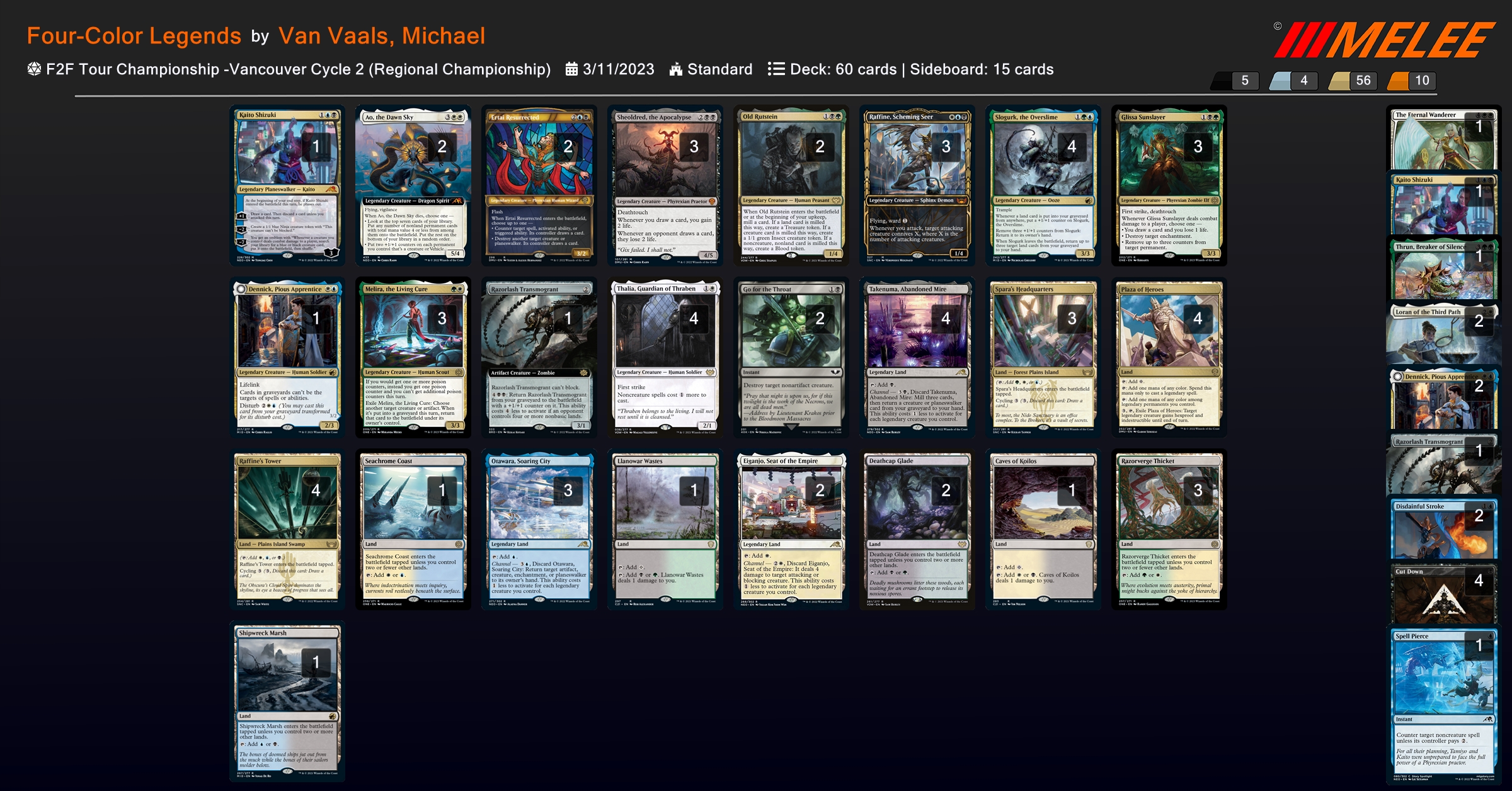
the Slogurk deck that got second place in a Canadian RC
The idea was that
Slogurk worked very well with Raffine and the legendary channel lands - Raffine could connive away lands to quickly grow Slogurk into a big beater, while the legendary lands let you turn Slogurk's trigger into more value. And both of those were also already powerful parts of the Legends shell!I experimented with Slogurk a bit then, but my conclusion was that, while it seemed like an okay variant of Esper Legends, I didn't think the extra power was quite worth the extra manabase inconsistency from going to 4 colors, and I wasn't sure I wanted to be playing Esper Legends in the first place.
Plus, in my opinion, the real draw to Slogurk was its staying power and card advantage. As a disruptive aggro deck that already had ways to grind, I didn't think Esper Legends needed something that went quite so over the top - it felt like Slogurk confused the deck more than it complemented it.
Later in testing, though, I had a thought: what if I slotted it into RataBlade?
Blade of Shared Souls copying Slogurk to legend rule and get back three lands seemed like a neat idea at first glance.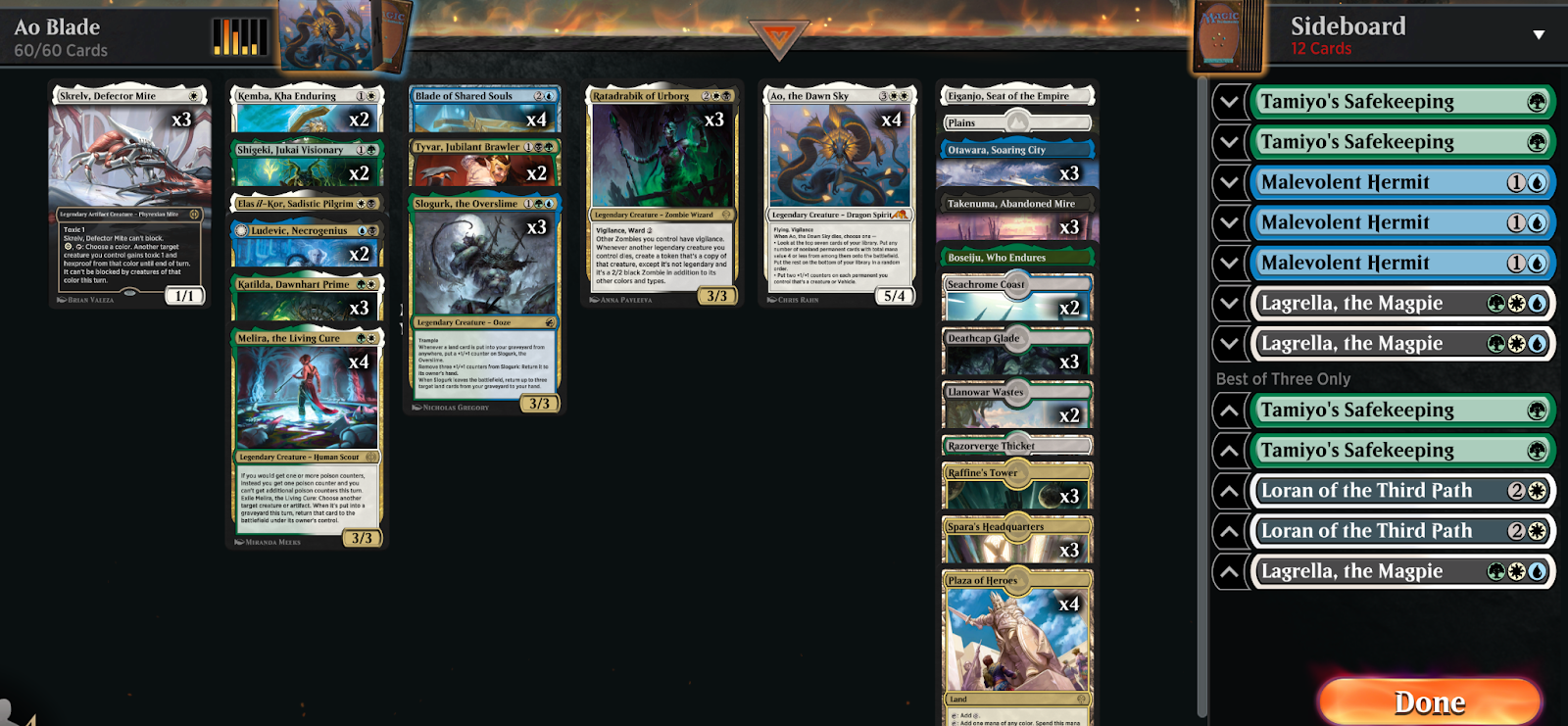
my attempt at a Slogurk RataBlade shell
Sadly, I quickly realized that it was a pretty bad fit - both Slogurk and RataBlade were lategame engines, and again they didn't particularly complement each other well. After that, I mostly discarded Slogurk for that RC, choosing to focus on RataBlade instead.
Part 2: If You Can't Beat Them, Join Them
After RC San Diego in April 2023, there was a lull in Standard activity for most, as there were very few Standard tournaments between then and Worlds in September. However, there was one quite important tournament for me: the VML Champs!
This was a 24-person invitational tournament, where the big prize was PT qualifications for the top 2. The formats were LTR draft and Standard - so throughout August, I was back to testing Standard once again.
At that point,
Fable and Invoke Despair had been banned, and the deck to beat was now UB Midrange. It just had the best interaction in the format - Go for the Throat and Make Disappear - back by okay threats.I spent a lot of time trying to make various combo decks work, to no avail. The interaction in the format was just a bit too good. So, I started looking for decks that specifically lined up well through the interaction in the format.
At some point, I remembered Slogurk. And Slogurk was perfect! It gets value when removed - including when exiled - and being a 3 mana card that serves as a lategame engine naturally plays quite well into Make Disappear as well!
I settled on Sultai quite quickly - you needed blue and green for Slogurk, obviously, but black for
Takenuma was also quite important to the lategame Slogurk engine. White for Eiganjo as recurrable removal would be nice, but I couldn't make a four color manabase work out.And besides, another one of the reasons I was excited about Slogurk was that Sultai let me play
Go for the Throat and Make Disappear. I wanted to lean on Slogurk's strength as a lategame engine, so I needed to have good earlygame interaction - and I didn't need Eiganjo for that.Here's the deck I ended up submitting for the VML Champs. Sadly, I went 0-3 in the draft portion, and didn't really end up getting to show off the Slogurk deck.
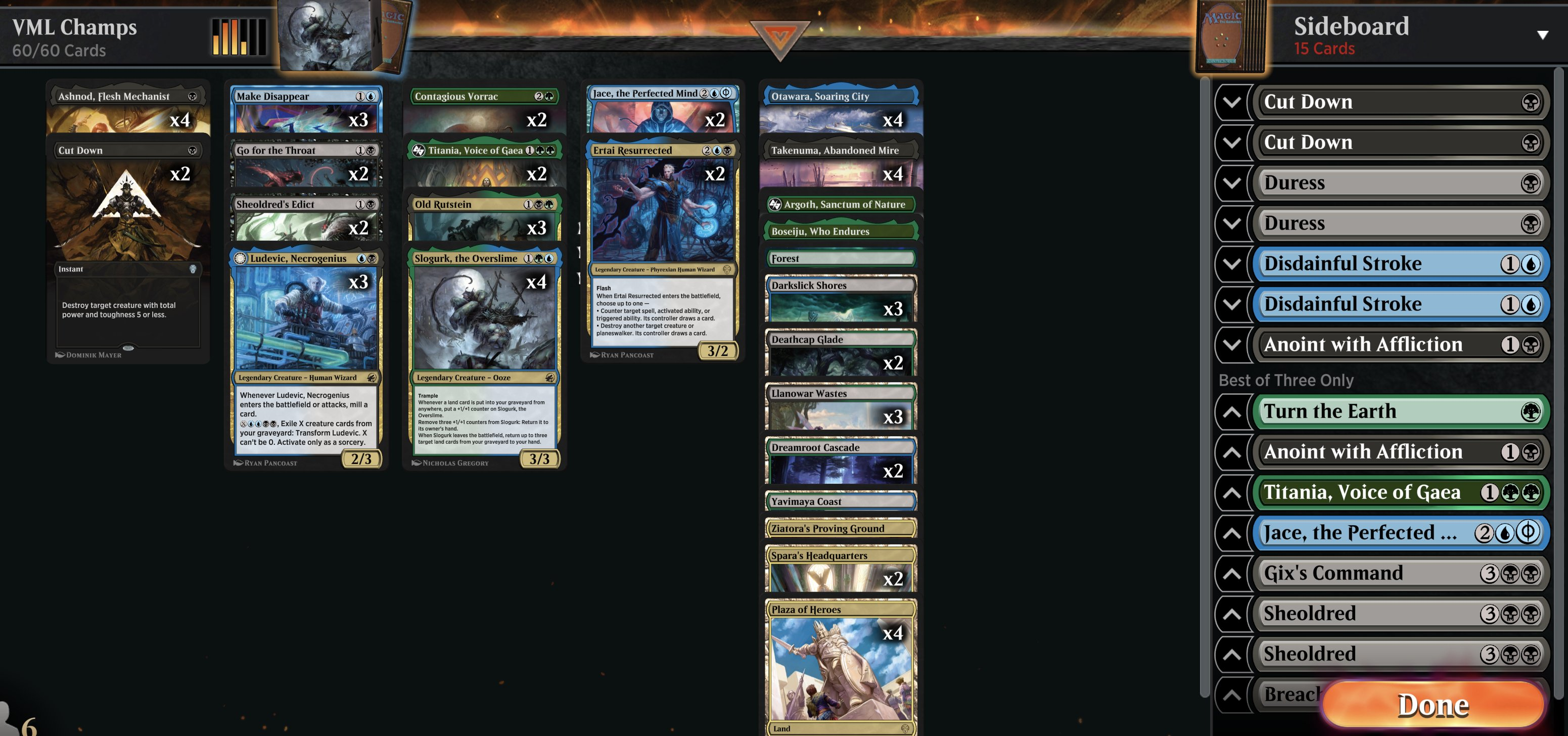
my VML Champs Slogurk deck, complete with one sideboard card for the mirror
Since then, I haven't worked on the deck too much in detail, but I did touch it up a bit for the most recent Arena qualifier weekend, adding WOE cards and adjusting card choices to better fit the new meta. Here's an updated list; warning that the numbers are overall a bit less tuned than the previous one, but probably better for the current meta:
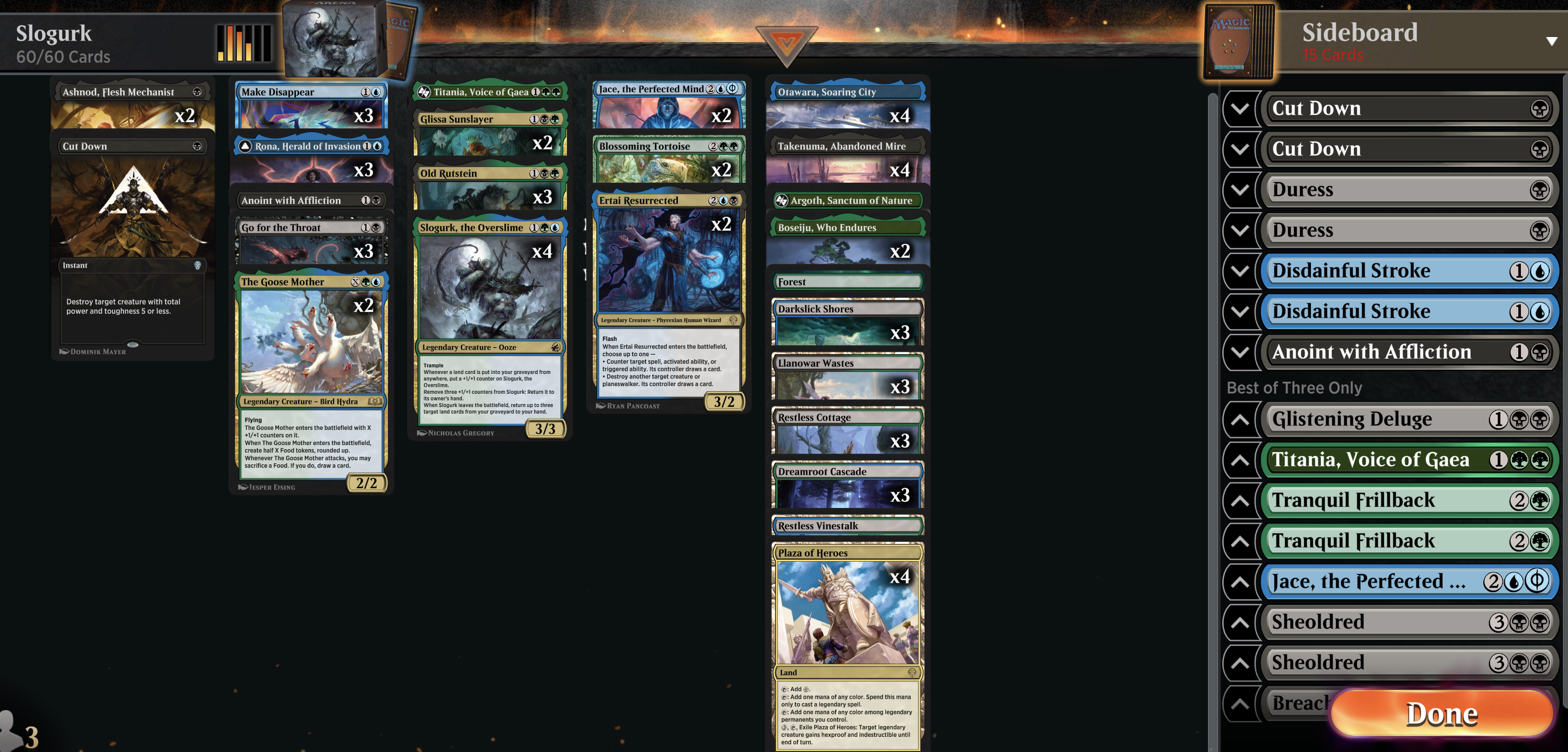
my latest Slogurk list
Part 3: The Core Loop
The goal of this deck is to go over the top of every opponent (yes, even ramp), locking them out from ever interacting profitably with you or killing you by invalidating any possible card they could cast.
So how do we do that? Well, this really just involves three cards:
Slogurk, Takenuma, and Otawara. Additional legends are technically somewhat necessary to be able to afford channeling so much, but it doesn't matter which legends they are, and they're fairly easy to assemble.Say we have Slogurk in play and Otawara in hand. We can channel Otawara to pick up Slogurk (or just use Slogurk's ability, removing three counters) - this will then trigger Slogurk, returning the Otawara we channeled from graveyard to hand, along with two other lands. So, we can channel more Otawaras to bounce our opponent's permanents, or Takenumas to get back creatures or planeswalkers from our graveyard; or we can just hit our land drops.
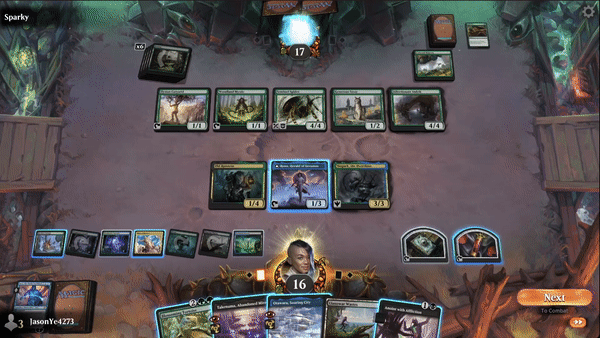
a demonstration of Otawara looping
Now say we instead channel a Takenuma. First of all, Slogurk will get a counter from the Takenuma, and a counter for each land the Takenuma mills. This can easily be three counters from a single Takenuma (just need to mill 2 lands in 3 cards) - enough to bounce Slogurk back to hand, and loop in a similar fashion as above.
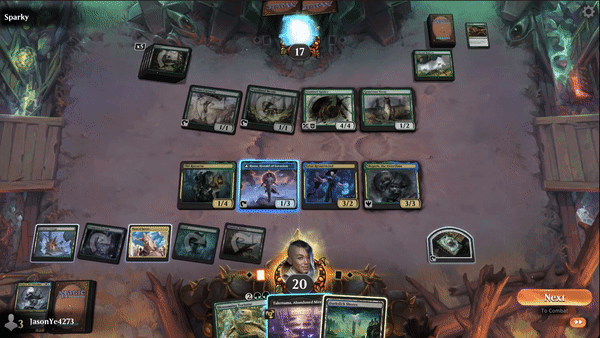
a demonstration of Takenuma looping
Alternatively, if we have a second Slogurk in the graveyard, we can get that back, play it, sacrifice it to legend rule, and get a Slogurk trigger that way - all while keeping our bigger Slogurk on the battlefield.
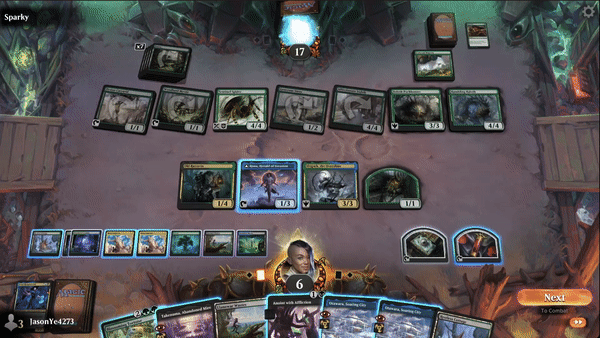
an alternate way to loop Takenuma that keeps a Slogurk in play
So, with all of this, it's very easy to loop Slogurk - the only constraint is mana. And with two other legends on the battlefield, channeling only costs 1 mana - so we can easily get to a state where we're playing a Slogurk and channeling three lands every turn. Once it gets going, very few decks can keep up.
Part 4: Immune to Interaction
One of the biggest reasons Slogurk is so potent as a lategame engine is because it is actually quite difficult to interact with.
It's naturally resilient to removal - its ability to spend three +1/+1 counters to return itself to hand can be activated at instant speed, and threatens to turn any removal spell pointed at it into simply an unsummon.
And since its ability to rebuy lands from the graveyard is a leaves-the-battlefield trigger, and not a death trigger, it triggers when Slogurk is exiled - and, importantly, when it's bounced. Any attempt to remove Slogurk will at minimum give you the rebate of three lands from your graveyard, and often will simply end up with Slogurk back in your hand anyways.
What's more, since all of the channel lands can be channeled at instant speed, you can use them in response to removal - thus representing extra counters on Slogurk in response to the removal, which can then perhaps be spent to rebuy Slogurk to your hand. And even if you don't have an Otawara to bounce Slogurk or enough counters to use its ability, and lands channeled in response to removal can come straight back to your hand from Slogurk's LTB ability.
So single target removal is quite mediocre against Slogurk once you get setup. But somehow, enchantment-based removal is even worse. With 4 copies of Otawara and 1-2 copies of
Boseiju, there are many ways to remove an enchantment at instant speed. So you can let a Leyline Binding exile Slogurk, use the LTB trigger to get back an Otawara and two other lands, and then use that Otawara to bounce the Binding again - they could recast it, but they're not really accomplishing much, other than running your engine for you.Sunfall and other sweepers pose a slightly more challenging problem - after all, while it's easiest to protect Slogurk, having other legends on the battlefield is a key part of reducing channel costs to smoothly run your engine. But it isn't too hard to play around this - with enough counters on Slogurk, you can potentially use Otawara to save your other legends, and use Slogurk's bounce ability to save itself.
Of course, one of the best pieces of interaction against Slogurk (not counting sideboard cards) is countermagic. After all, you can't save Slogurk from being countered with a channel land, and you don't get to rebuy lands when it gets countered. Thankfully, hard countermagic is not a particularly big part of the meta, and Make Disappear is easy to play around when you naturally want to cast Slogurk with mana open for a channel land followup anyways.
Part 5: The Rest of the Deck
So that's the engine, what it does, and why it's resilient. Now let's talk about the rest of the deck, which suppports and facilitates getting to that engine. I won't go into too much specific detail, as the exact build of this deck will probably change as the meta changes and with the new set release; instead I will go over broad strokes of core pieces.
The Lands
First of all, we need a manabase. Of course, we want the channel lands - 4 copies each of Takenuma and Otawara are a given, as they represent the core loop of our engine. We want some number of Boseiju, depending on how good it is in the meta. And finally, we also want Plaza of Heroes, as we will naturally want to play many legends.
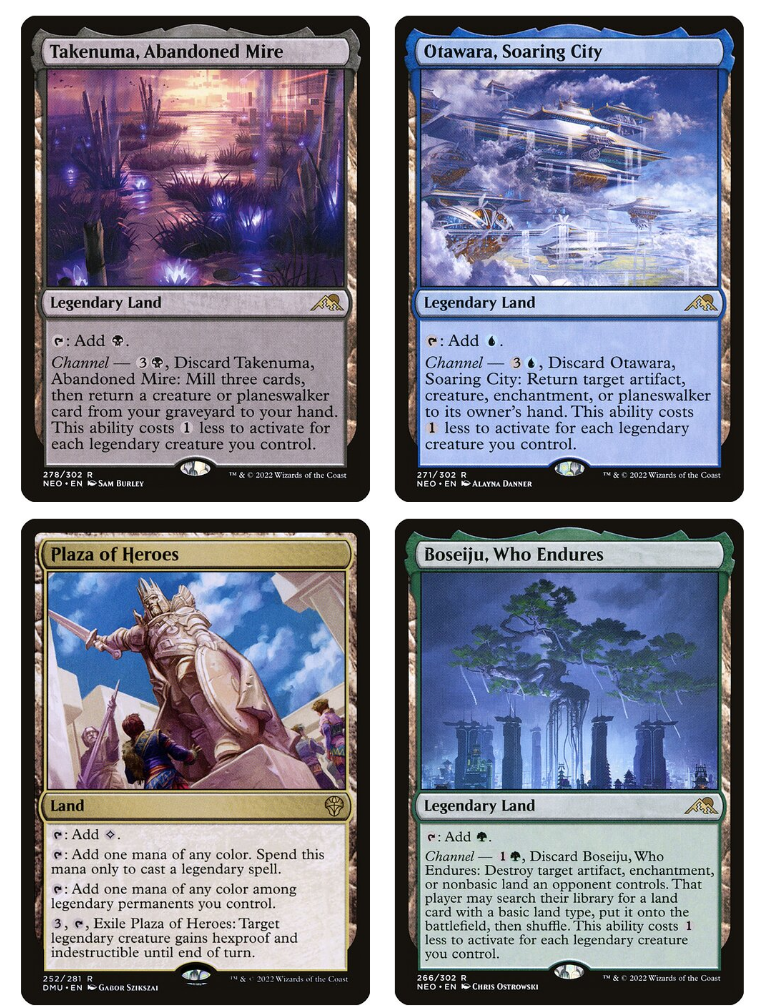
the core lands
Overall, I would recommend playing 29 or 30 lands total - this may seem like a lot, but we have a lot of mana sinks, and we often will want to avoid playing channel lands, treating them as spells instead.
The Legends
Next, we need a suite of legends. We don't need to lean super hard into it, but we do want to consistently be able to stick a few legends on the board to reduce channel costs.
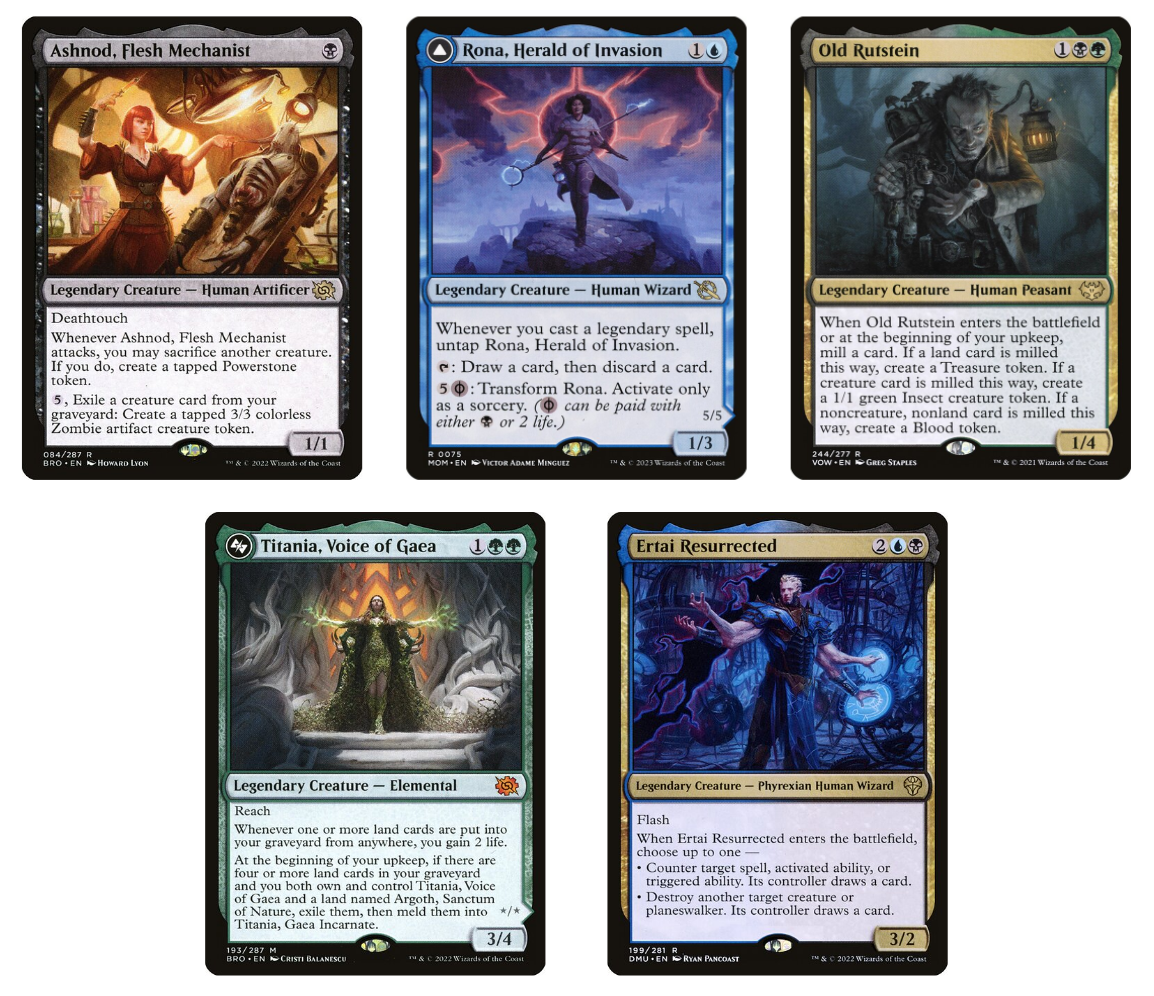
the core legends
Ertai is very important, as a piece of interaction and countermagic that can be an output of our engine, as Otawara can rebuy it from the battlefield and Takenuma can rebuy it from the graveyard.
Old Rutstein and Rona are great legends to play early - they both churn through our deck to find engine pieces while filling the graveyard and generating value. They help ensure that we can, at some point, play Slogurk with lands in the graveyard so we get value even if it dies.
Titania is a nice tempo piece - it's a very good blocker, and can gain quite a lot of life as we mill or channel lands. It might be weird not to see
Sheoldred in this slot, but 3 mana is so much less than 4, reach is quite relevant, and Titania often even gains more life more immediately compared to Sheoldred. And, of course, it's not that hard to assemble Titania's meld - we can go through a lot of our library and get the land back with Slogurk, and that can be a quick way to close out a game.Finally, Ashnod might seem like a weird choice. We don't particularly have much fodder to sac, we can't use the powerstones too much anyways, and we don't really need the mana sink. But really all that is unimportant - what matters here is just that it's a 1 mana legend. You can almost always play it for "free" as you get the mana back as soon as you channel a land, and it quickly starts to generate mana. It doesn't look like much, but it's quite important, and a 1/1 deathtouch isn't terrible either.
The Interaction
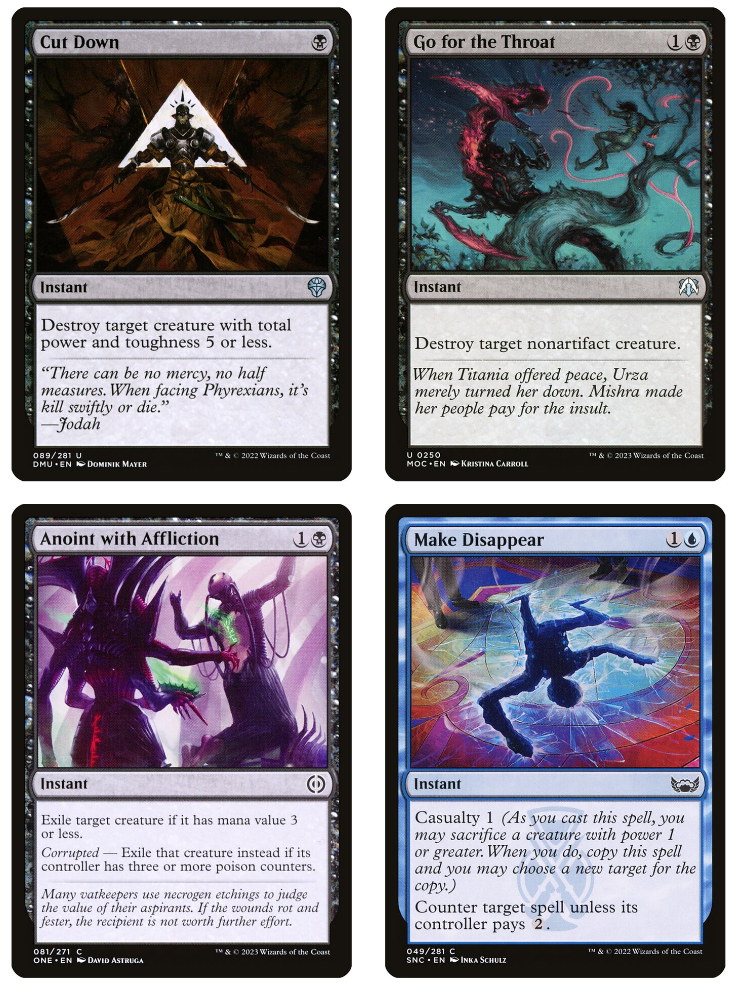
the core interaction
It's very nice that we get to play the best interaction package currently in standard - black removal and Make Disappear. Nothing much special here - except the Anoint with Affliction, which is specifically here because Dennick is a hate piece we want a good answer for.
The Alt Wincon
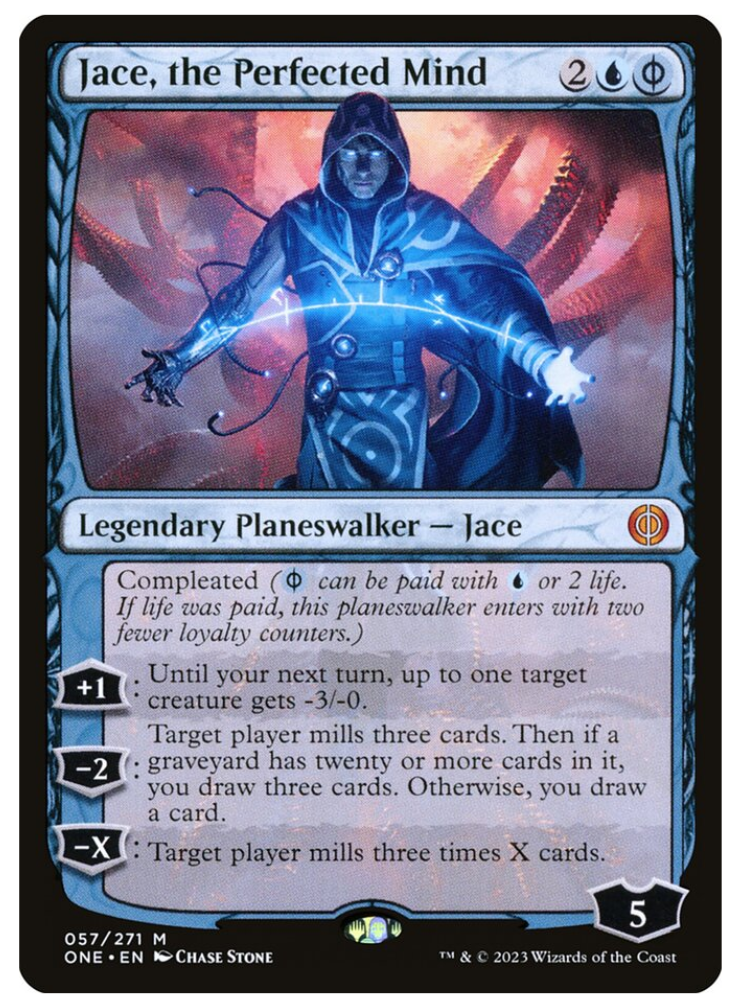
the alt wincon
Finally, we have Jace as both an early bridge and a way to close out the game late against slower decks. It can be hard to close with combat damage sometimes against decks with a lot of removal, but in that case, we can simply rebuy Jace several times with Takenuma for a mill victory.
(A less common, but funnier line is milling ourselves for 15 with Jace - with a Slogurk in play, this can represent a lot of counters out of nowhere, and perhaps lethal)
Part 6: New Cards, or Lack Thereof
[EDIT: wow was I wrong on this one. See my next article for details on how LCI broke this deck lol]
Here is where I wish I could tell you about all the new cards from LCI that improve the deck. But unfortunately, there really isn't anything that looks too significant.
You'd think that a set where some of the central mechanics revolve around graveyards and lands would be better for Slogurk, but sadly there just isn't anything that quite fits.
The Ancient One looks like it could be good as a cheap legend, but I think it's a bit too dependent on the graveyard - some of the games this deck struggles with more are the ones where it can't fill its graveyard, and Ancient One just magnifies that problem even more without helping the problem much.
There is a bunch of self-mill stuff in the set, like
The Everflowing Well, but nothing that really looks efficient enough to be good for the deck. Maybe Throne of the Grim Captain would be reasonable if you could ever transform it, but sadly it's pretty hard to find playable creatures of those types.The only card that I can really see making the deck is
the new UB creature land, but it's really not a huge upgrade; the WOE creature lands were already pretty good.Conclusion
There's a lot more I could say about this deck, but I don't want to get too much into the weeds, especially as a new set is releasing and the meta's going to change. There's many different ways you could try to build this deck, and many card choices I could go into that have various advantages and disadvantages.
But ultimately, my goal here is simply to lay out the foundation of this powerful Standard engine. I probably won't be working much on it, as I have limited time and no reason to focus on Standard. But I hope someone can take this deck further - maybe one day it'll become part of the meta.
#FreePalestine | Consider donating to UNWRA or PCRF, supporting protesters locally, and educating yourself.
